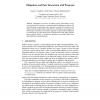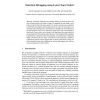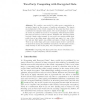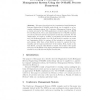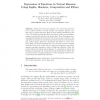ESORICS
2007
Springer
14 years 5 months ago
2007
Springer
Obligations are pervasive in modern systems, often linked to access control decisions. We present a very general model of obligations as objects with state, and discuss its interac...
ECML
2007
Springer
14 years 5 months ago
2007
Springer
Abstract. Statistical debugging uses machine learning to model program failures and help identify root causes of bugs. We approach this task using a novel Delta-Latent-Dirichlet-Al...
ECAL
2007
Springer
14 years 5 months ago
2007
Springer
Anticipation is one of the key aspects involved in flexible and adaptive behavior. The ability for an autonomous agent to extract a relevant model of its coupling with the environ...
CONTEXT
2007
Springer
2007
Springer
Context-Sensitivity of Human Memory: Episode Connectivity and Its Influence on Memory Reconstruction
14 years 5 months ago
This paper is testing a DUAL-based model of memory. The model assumes decentralized representation of episodes as a coalition of agents and analogical transfer processes as the bas...
CAIP
2007
Springer
14 years 5 months ago
2007
Springer
A novel approach towards a simplified, though still reliable human vision model based on the spatial masking properties of the human visual system (HVS) is presented. The model con...
B
2007
Springer
14 years 5 months ago
2007
Springer
Following a brief discussion of uniprocessor scheduling in which we argue the case for formal analysis, we describe a distributed Event B model of interrupt driven scheduling. We �...
ASIACRYPT
2007
Springer
14 years 5 months ago
2007
Springer
We consider a new model for online secure computation on encrypted inputs in the presence of malicious adversaries. The inputs are independent of the circuit computed in the sense ...
AOSE
2007
Springer
14 years 5 months ago
2007
Springer
This paper describes how the Organization-based Multiagent Systems Engineering (O-MaSE) methodology can be applied to an exemplar multiagent system, the Conference Management Syste...
AIME
2007
Springer
14 years 5 months ago
2007
Springer
This paper presents the cognitive model of gastroesophageal reflux disease (GERD) developed for the Maryland Virtual Patient simulation and mentoring environment. GERD represents a...
ACII
2007
Springer
14 years 5 months ago
2007
Springer
Abstract. Artists use words, lines, shapes, color, sound and their bodies to express emotions. Virtual humans use postures, gestures, face and voice to express emotions. Why are th...
